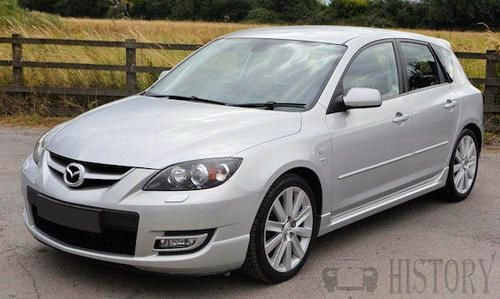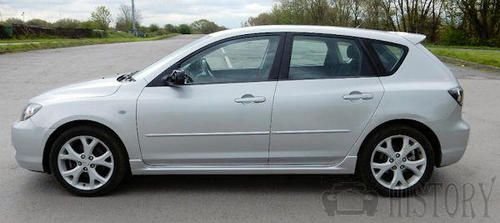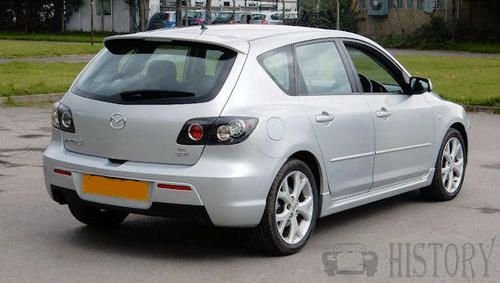Mazda3 First generation
 |
|
| Production | 2003–2009 2006–present (China), 2005–2010 Tehran, Iran,2003–present (Colombia) |
|---|---|
| Assembly | Hofu, Japan Nanjing, China Taiwan, Republic of China Bogotá, ColombiaPretoria, South Africa Willowvale, Zimbabwe (WMMI)Santa Rosa, Laguna, Philippines |
| Platform | Mazda BK platform |
| Engine | 1.4 L MZR I4 1.5 L MZR I4 1.6 L MZR I4 2.0 L MZR I4 2.3 L MZR I4 1.6 L MZ-CD I4 2.0 L MZR-CD I4 |
| Transmission | 4-speed automatic 5-speed automatic 5-speed manual 6-speed manual |
| Wheelbase | 2,639 mm (104 in) |
| Length | 2004–06 i Sedan: 4,529 mm (178 in) 2004–06 s Sedan: 4,540 mm (179 in) 2004–06 Hatchback: 4,485 mm (177 in) 2007–09 i Sedan: 4,506 mm (177 in) 2007–09 s Sedan: 4,511 mm (178 in) 2007–present Hatchback: 4,591 mm (181 in) |
| Width | 1,755 mm (69 in) |
| Height | 1,465 mm (58 in) |
| Curb weight | 1346–1410 kg (2969–3108 lb) |
| Related | Mazda Premacy/Mazda5, Ford Focus, Volvo C30, Volvo S40/Volvo V50 |
The Mazda3 has been generally well received by the automotive press for its performance, handling, styling and interior, with some describing it as feeling like a more expensive sport sedan despite its value-oriented price.Some criticisms have included fuel economy and crash test results (only receiving four out of a maximum five stars from the EURO NCAP Safety Testing Programme) the latter of which was rectified by making six airbags standard.In 2006 the Mazda3 was the second best-selling car in Canada and the best selling car in Israel during 2005–2007.
Design
The Mazda3 is based on the Ford global C1 platform, shared with the latest European Ford Focus and Volvo S40. Based on the styling of the MX-Sportif concept car, the Mazda3 is available in two body styles, a four-door sedan, marketed as "coupé style" in Europe, and a five-door hatchback, branded the Sport version in Canada, Japan, and the United States. The lead stylist for this model generation was Moray Callum.
The front suspension comprises MacPherson struts, with coil springs and an anti-roll bar. The rear suspension is a Ford-designed "E-link" multi-link suspension, with four locating links per wheel and an anti-roll bar, suspended on coil springs that are mounted inboard of the shock absorbers to reduce suspension intrusion into the cargo area. Four-wheel Disc brakes are fitted, with 300 mm (11.8 in) discs in the front and 279 mm (11 in) discs in the rear; ABS and electronic brake force distribution are available or standard, depending on the model. Wheel and tire sizes vary with model, from 15" on base models to optional 17" wheels on upper-level models.
When first introduced, United States-market Mazda3 models were available in only two trim levels, i and s, with the 2.0 L and 2.3 L engines, respectively. Since then Mazda has introduced additional models under the Touring and Grand Touring labels. British Mazda3s are offered in S, TS, TS2, Sport, and a top end 2.3ltr turbocharged Mazda3 MPS (Mazda Performance Series) models. Since April 2008, when there was a mainly cosmetic facelift of the Mazda3, there have been some changes to the trim designations for UK cars, with the models now being the entry level S, then Takara (which replaces TS & TS2), the Tamara Special Edition and the Sport and MPS as before.
All 3 models use the inline-4 Mazda MZR engine, with various types, displacements and outputs including the MZ-CD turbodiesel, depending on model and market. Transmissions are a five-speed manual transmission and a four-speed automatic transmission; since the 2006 model year, a five-speed automatic is optional on models with the 2.3 L engine. This transmission has now been made standard on the 2.0 L engine in Japan (FWD models only), as part of a minor facelift in early 2008 which includes different front/rear bumper designs, new wheel designs and body colors, stiffened chassis, and better interior materials. The MPS / Mazdaspeed version is only available with a six-speed manual.
Basic equipment
The basic equipment that is standard across all versions of the Mazda 3 Saloon from 2004 to 2008.
|
Performance
Official performance figures for the European Mazda3 1.4 S, the lowest-powered model, are 0–100 km/h in 14.3 seconds, with a maximum speed of 170 km/h (106 mph). Wheels magazine reported an 8.7 second 0–100 km/h time for the Australian 2.0 model in its May 2004 issue.
The 1.6 CiTD 80 kW diesel (as sold in Europe) with a five-speed manual does 100 km/h in 11.6 seconds and has top of 182 km/h (113 mph) according to the official Mazda specifications.
In test results for the 2012 Mazda 3 Maxx Sport 5-door 2.0 litre engine, it has been reported of an accelaration time of 9.2 seconds(0–100 km/h)and a top speed of 190 km/h.
In its test results for the 2004 Mazda3 5-door with the 2.3 litre engine, Car and Driver magazine reported a 0-60 mph (0–97 km/h) acceleration time of 7.4 seconds and a governor-limited top speed of 190 km/h (118 mph).
The fuel consumption of these models average in the 10 L/100 km (24 mpg-US; 28 mpg-imp), with the 2 litre 2008 Mazda3 automatic-transmission model scoring a 10 L/100 km (24 mpg-US; 28 mpg-imp)/7.6 L/100 km (31 mpg-US; 37 mpg-imp) city/highway United States Environmental Protection Agency (EPA) rating.
The Mazda 3's maximum power is 108kW @ 6500 rpm which allows for it to enhance in its performance.

2006
For the 2006 model year, Mazda added variable valve timing and variable-length intake runners to the 2.0 L engine resulting in a power increase to 150 bhp (112 kW; 152 PS). The automatic transmission used in Mazda3 S trim with the 2.3 L engine was changed from a four-speed to a five-speed design. The larger 2.3 L engine was PZEV-certified (Partial Zero Emissions Vehicle) for vehicles sold in California and other states that have adopted California automotive emission standards. The 2.0 L engine had already been PZEV-certified. The colour palette was also simplified in 2006, with the deletion of Canary Yellow and Lava Orange Mica.
2007
The 3 received a minor cosmetic facelift for the 2007 model year with minimal exterior, interior and mechanical changes. On base models, the black plastic at the top of the grille became body-coloured. The front fascia and bumper were changed with a floating foglight design and the lower air intake opening was reshaped to better resemble the typical "Mazda five-point face." All Mazda3 sedans and five-doors gained the same "Axela" clear-lens style rear tail-lights as the SP23 model. Which in 2007 Mazda brought out the Mazda Axela similar to the Mazda6 Atenza . In addition, the Grand Touring trim also featured LED brake lights. The LED brake lights were added to compete with the growing trend of higher-end vehicles using LED tail lamps for more visible light output. The range of alloy wheels were redesigned, featuring a 17 inch alloy wheel for the Grand Touring version. The rear fascia was slightly changed adding a notch on the bumper cover of the sedan. Several new exterior colors were added, phantom blue, a copper red metallic (April 2008), Aurora Blue and dark cherry. The Titanium Gray color was replaced with a darker Galaxy Gray color.
The interior of the Mazda3 was offered with several new color choices and an audio jack in the centre console, allowing the use of digital music players. Also, Takara models, which were introduced in the 2008 upgrade, added climate control and 6 cd autochanger to the TS specification.
The 2007 model also includes less visible mechanical changes. The keyless entry system was improved. Reinforcements to the body shell improve overall chassis rigidity. The front dampers of the MacPherson strut suspension have been re-tuned to quicken steering response and reduce understeer. The hydraulic dampers of the multi-link rear suspension were also re-tuned to match the front suspension changes. Mazda engineers and designers addressed concerns regarding cabin noise level by redesigning or changing multiple systems and adding sound-deadening material to the roof lining and hood panel.
The bumper-to-bumper warranty was reduced to 36 months / 36,000 miles while the powertrain warranty was increased to 60 months / 60,000 miles in most markets. In the UK all Mazda3s have a 3 year unlimited mileage warranty, 3 year roadside assistance and 12 year anti perforation warranty as standard.
Canadian Mazda3s received standard seat mounted side-airbags and body shell mounted side curtain airbags across the model range. Previously both airbag types were not available.
2008
In Canada, the 2008 model year was replaced in Spring 2008.
An additional trim level included the Sport GX with a 2.0L engine, previously all Sport hatchbacks had a 2.3L engine and came only in GS or GT trims. Compared to the GX sedan, the GX hatchback has body-coloured door handles, and fog lamps. Options for the Sport GX include air conditioning, a convenience package containing power accessories and 15-inch alloys, and a rear trunk spoiler.
The GS sedan received standard 16-inch alloy wheels, previously only available with the moonroof option, while the GX had 15-inch alloy wheels added to the convenience package (which includes steering-wheel mounted audio controls, power windows, power locks, and remote entry). The GS hatchback now comes with factory-installed air conditioning. GT models received standard xenon headlights, previously part of the leather package.
In the U.S., the i Touring trim level was replaced by the i Touring Value model. This new model added a body-color front grille, fog lights and 17" alloy wheels, giving it a very similar appearance to the more expensive s models. The interior also received leather-covered steering wheel and shift knob from the s model. Anti-lock brakes and side-impact airbags, previously optional, were now standard.
2009
Initial news reports indicated the 2009 model year would receive a minor face-lift with exterior design modifications that included chrome door handles, a new roof spoiler, expanded use of black moldings on the rear bumper, and new alloy-wheel options. This turned out to not occur in the US or Canadian market. The 2009 model year was only a few months long as production ceased in November 2008.

Technical
-
Options Equipment included on some trim levels - Air conditioning
- CD
- CD Multichanger
- Climate control
- Cloth seat trim
- Cruise control
- Front fog lights
- Headlight washers
- Leather seat trim
- Space saver spare wheel
- Traction control
Engines
The Mazda3 features the following engines:
Japanese market (JIS ratings):
- 1.5 L: 118 PS (87 kW), 140 N·m (103 lb·ft)
- 2.0 L: 150 PS (110 kW), 183 N·m (135 lb·ft)
- 2.3 L: 171 PS (126 kW), 214 N·m (158 lb·ft)
European market (ECE ratings):
- 1.4 L: 84 PS (62 kW), 122 N·m (90 lb·ft)
- 1.6 L: 105 PS (77 kW), 145 N·m (107 lb·ft)
- 2.0 L: 150 PS (110 kW), 187 N·m (138 lb·ft)
- 2.3 L MZR DISI Turbo: 260 PS (191 kW), 380 N·m (280 lb·ft)
- 1.6 L MZ-CD common-rail diesel: 109 PS (80 kW), 240 N·m (177 lb·ft)
- 2.0 L MZR-CD common-rail diesel: 143 PS (105 kW), 360 N·m (266 lb·ft)
- 2.2 L MZR-CD common-rail diesel: 185 PS (136 kW), 400 N·m (295 lb·ft)
American & Canadian markets (SAE net ratings):
- 2.0 L: 148 bhp (110 kW), 135 lbf·ft (183 N·m) (04–05) PZEV engine: 145 bhp (107 kW) (04–06), 144 bhp (107 kW) (07–); 132 lbf·ft (179 N·m) (all years)
- 2.3 L: 160 bhp (119 kW), 150 lbf·ft (203 N·m) PZEV engine: 153 bhp (113 kW), 149 lbf·ft (202 N·m) (2006 only)
- 2.3 L MZR DISI Turbo: Mazdaspeed3: 263 bhp (196 kW), 280 lbf·ft (380 N·m)
Mazda changed the rating for US & Canadian markets 2007 2.3 L naturally aspirated engine:
- 2.3 L: 160 bhp (119 kW), 150 lbf·ft (203 N·m) PZEV engine: 151 bhp (113 kW), 149 lbf·ft (202 N·m) (07–)
ASEAN markets (DIN ratings):
- 1.6 L: 110 bhp (78 kW), 107 lbf·ft (145 N·m)
- 2.0 L: 148 bhp (110 kW) and 138 lbf·ft (187 N·m)
Australian market (ADR net ratings):
- 2.0 L: 145 bhp (108 kW), 134 lbf·ft (182 N·m)
- 2.3 L: 154 bhp (115 kW), 150 lbf·ft (203 N·m)
- 2.3 L: DISI MZR: 260 bhp (190 kW), 280 lbf·ft (380 N·m)
- 2.0 L MZR-CD common-rail diesel: 143 PS (105 kW), 360 N·m (266 lb·ft)
South African market (DIN net ratings):
- 1.6 L: 109 bhp (77 kW), 108 lbf·ft (146 N·m)
- 2.0 L: 140 bhp (104 kW), 134 lbf·ft (182 N·m)
- 2.3 L: 154 bhp (115 kW), 150 lbf·ft (203 N·m)
- 2.3 L: DISI MZR: 260 bhp (190 kW), 280 lbf·ft (380 N·m)
Service
-
Mazda model 3 service guide
Mazda Model: 3 Petrol 1,4 Engine 1,6 Engine 2.0 Engine
Firing order 1-3-4-2
Spark plugs Original equipment Denso Type SK16PR-E11
Spark plug Electrode gap 1.0-1.1mm
Engine oil grade - cold climate 5W/30 Semi-synthetic SAE or 10W/40 Semi-synthetic SAE
Engine oil grade - normal climate 5W/30 Semi-synthetic SAE
Engine oil grade - hot climate 10W/40 Semi-synthetic SAE
Engine with filter 3.9 litres
Manual gearbox oil grade 75W/90 SAE 3.0 litres
Cooling system 6.0 litres
Brake fluid Type DOT 3/4
Power steering fluid Type ATF M-III 1.2 litres
Road wheels tighten to 88-118 Nm
Parking brake travel No. of notches 3-6
Air conditioning refrigerant Type R134aNo. of cylinders 4/DOHC
Capacity 1349 cc
Compression ratio 10.0:1
Minimum octane rating 95 RON
Fuel system System pressure 3.5-4.1 bar
Injector 13.8 Ohm
Compression pressure 10.2-14.6 bar
Oil pressure bar/rpm 3.3-3.8/3000
Radiator cap bar 0.9-1.1
Thermostat opens 80-84 °1.6 petrol specific
No. of cylinders Type 4/DOHC
Capacity 1596 cc
Compression ratio 10.0:1
Firing order 1-3-4-2
Spark plugs Original equipment Denso Type SK16PR-E11
Electrode gap 1.0-1.1 mm
Valve clearance -INLET 0.27-0.33 mm cold
Valve clearance -EXHAUST 0.27-0.33 mm cold2,0 litre specific
No. of cylinders Type 4/DOHC
Capacity 1999 cc
Compression ratio 10.8:1
Firing order 1-3-4-2
Spark plugs Original equipment NGK Type ITR6F13
Spark plug Electrode gap 1.25-1.35mm
Fuel system System pressure 3.5-4.1 bar
Valve clearance -INLET 0.22-0.28 mm cold
Valve clearance -EXHAUST 0.27-0.33 mm cold
Engine with filter 4.3 litres© motorcar history

